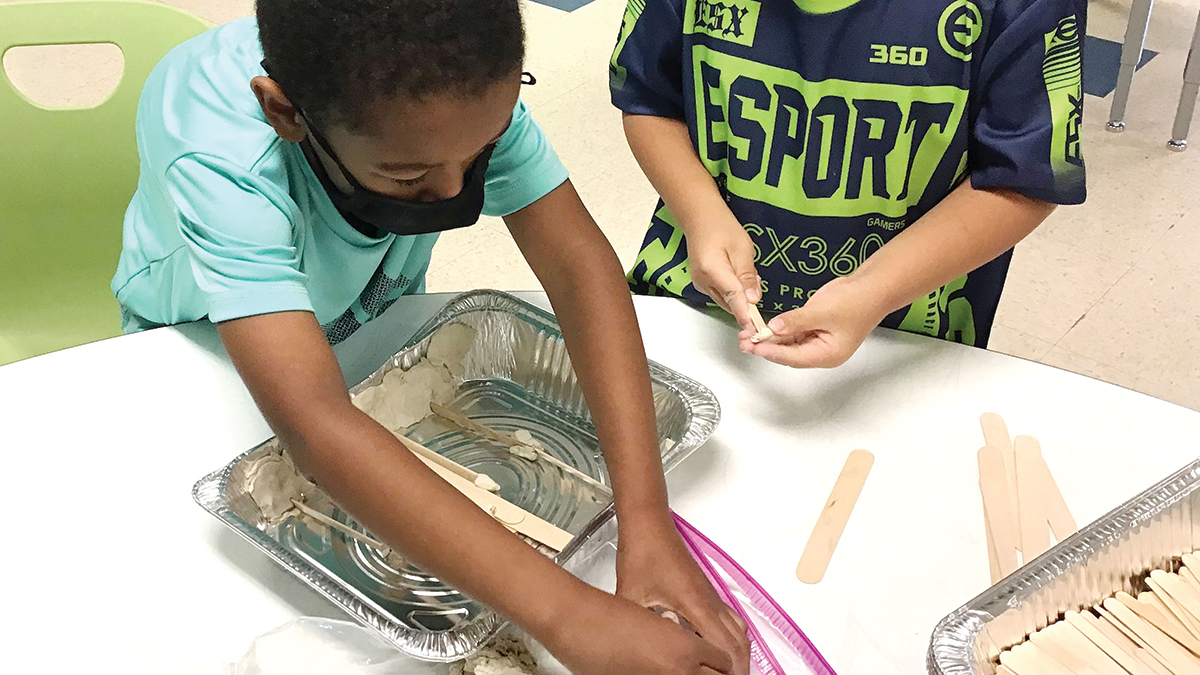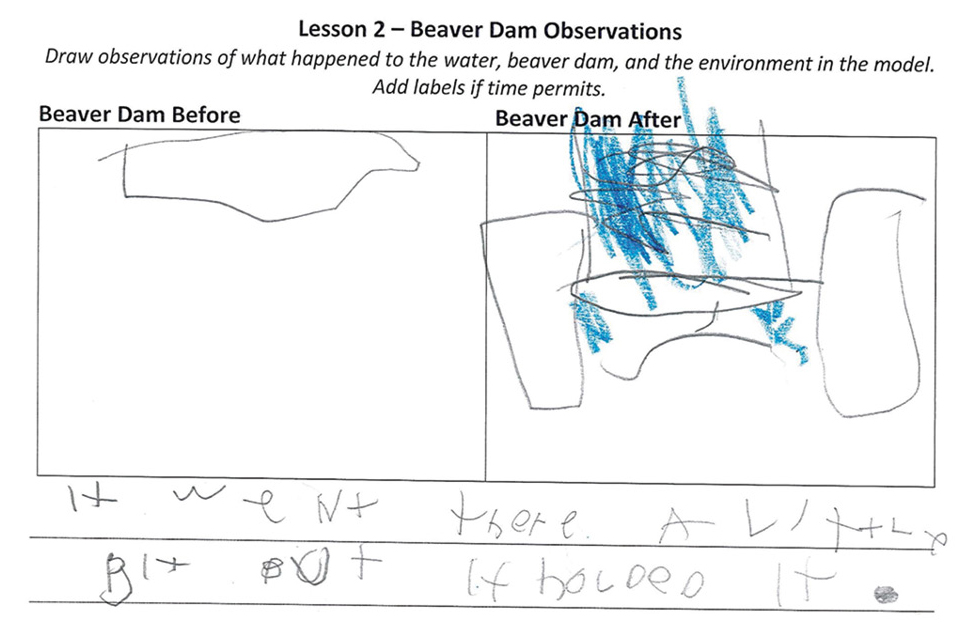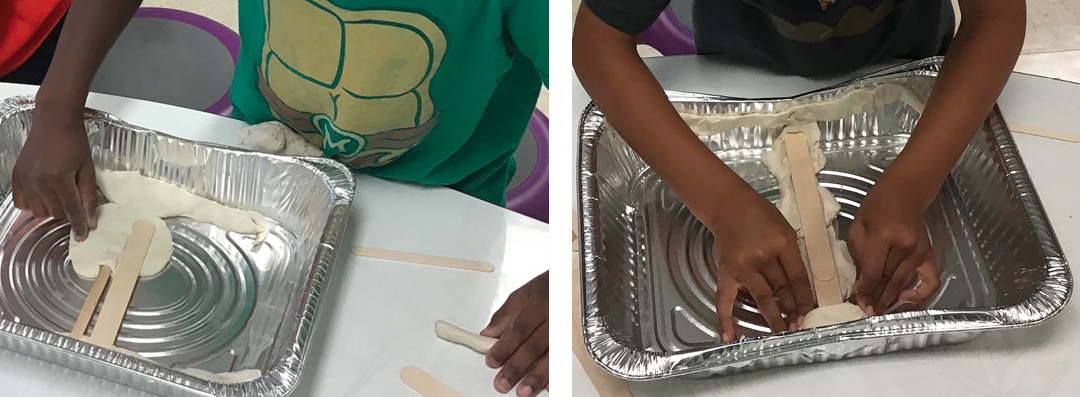feature
Modeling, Reading, and Talking, Oh My!
Using multiple modes to promote sensemaking and scientific literacy in the early elementary grades
Science and Children—July/August 2022 (Volume 59, Issue 6)
By Miranda S. Fitzgerald, Amber S. Bismack, Amelia Wenk Gotwals, Tanya S. Wright, and Erin K. Washburn

“Do trees die in the winter?” Questions like this are common curiosities children have as they explore the world around them. They may notice ants walking by, or wonder about the movements of the Sun and Moon. These wonderings guide their exploration of their surrounding environment and are the drive for current reforms in science education. In particular, the goal is to help children make sense of science phenomena, natural, observable events or things that exist and can be explained or predicted using science. This type of scientific sensemaking involves using investigations, models, and other resources such as texts to figure out how and why phenomena occur.
Scientific sensemaking is also supported by the Next Generation Science Standards (NGSS Lead States 2013) through the integration of science and engineering practices. When students use science and engineering practices to make sense of phenomena, they are also building scientific literacy. Scientific literacy refers to the ability to engage with science ideas through explaining phenomena scientifically, understanding how science knowledge is constructed, and interpreting evidence (Roberts and Bybee 2014). For example, knowing that claims should be supported with evidence from first- or second-hand data reflects an understanding of how we justify new ideas in science.
An important part of promoting scientific literacy is developing disciplinary literacy practices, such as obtaining information from text and sharing investigation results through talk and writing. To support students to develop disciplinary literacy practices in science, we must provide opportunities for them to work with multiple modes—resources for meaning-making—such as informational texts, photographs, videos, and physical materials. In this article, we share how teachers can support students as they investigate questions about the natural world, such as, How do animals change their environments?
Multimodality
Scientists use various combinations of modes—we refer to this as multimodality—as they use science and engineering practices to answer research questions and communicate findings (Lemke 2004). Examples of modes include oral language, movement, images, video, and designed objects. Coordinating modes is important because every mode has limitations; any single representation only partly reflects a phenomenon. For example, a photograph of a beaver dam allows students to make careful observations of the completed structure, while a video or physical model allows students to see how beaver dams are constructed and how they change the surrounding environment. As students investigate phenomena, opportunities to use multiple modes can support scientific sensemaking. Furthermore, use of multiple modes in the elementary grades is supported by the Common Core State Standards for English and Language Arts (NGAC and CCSSO 2010).
Use of multiple modes in both science and literacy instruction is also supported by research. Students who recognize relationships among modes demonstrate greater understanding of science ideas (Prain and Waldrip 2006). In literacy, when curriculum materials include multimodality, learners who have been perceived as “struggling readers” may experience greater success (Siegel 2006). Illustrations, for example, can serve as valuable meaning-making resources for less-proficient readers (Aukerman and Schuldt 2016). Supporting students to use multiple modes has the potential to support conceptual understanding and reposition learners who may typically struggle to make meaning with text. Thus, curriculum materials and instruction play important roles in supporting young learners to use multiple modes to develop scientific literacy as they make sense of phenomena.
The Ever-Changing Environments Unit
The SOLID Start project (Science, Oral Language, and Literacy Development from the Start of School is a free, open-source curriculum; see Online Resources) has designed curricula that integrate science and literacy with the goal of supporting early elementary students in making sense of science phenomena (Wright and Gotwals 2017). Within SOLID Start units, students are introduced to a driving question and puzzling phenomenon, and then use a variety of resources across a coherent set of activities to engage in sensemaking. Lessons include five instructional components—Ask, Explore, Read, Write, Synthesize—designed to promote science language development and deepen science learning through meaningful engagement in science discourse. Kindergarten students who participated in the curriculum significantly outperformed peers in making and supporting claims to provide scientific explanations and in science vocabulary (Wright and Gotwals 2017).
In the Ever-Changing Environments kindergarten unit, students engage in multiple investigations and work with ant farms, models, photographs, videos, and informational texts to answer the unit driving question, Why do animals and plants change their environments? During the unit, students investigate what plants and animals need to survive; why they live in certain places; and how and why ants, beavers, humans, and plants change their environments. For example, students make claims about how ants change the surrounding environments over time by observing ant farms and how beavers change the surrounding environments by building and testing model dams. They end the unit by developing an informational text about ways to prevent humans from harming the environment to help ants survive. To highlight multimodal learning opportunities, we focus on one lesson from the unit, taught by Ms. Ortiz (all names are pseudonyms), who invited us into her classroom to observe and collect student work samples.
Context
We share examples from Ms. Ortiz’s summer reading camp (SRC) classroom to illustrate how she leveraged and extended the use of multiple modes within the unit to foster students’ scientific literacy and sensemaking about why plants and animals change their environments.
Ms. Ortiz, an experienced English as a Second Language (ESL) teacher, taught the Ever-Changing Environments unit during the last three weeks of a six-week camp to four small, multi-age groups (four to six students per class) of rising first- through third-grade students at a K–3 public charter school in an under-resourced community. Due to COVID-19 related disruptions, students had no science instruction during the academic year. The SRC was open to all students who attended the school during Spring 2021. The majority of SRC students came from historically marginalized populations with 70% of students qualifying for free or reduced-price lunch, and included students with diverse oral language and literacy skills, students with developmental disabilities, and emergent multilingual learners.
Leveraging Multiple Modes in SOLID Start Lessons
In the second lesson of the unit, students make sense of how beavers change their environments by reading an informational text, watching a video about beavers, and building and testing a model beaver dam. In the following examples, we illustrate how Ms. Ortiz and her students interpreted and communicated information using a variety of modes to support sensemaking.
ASK: Reviewing the Driving Question
As an ESL teacher, Ms. Ortiz frequently paired movement and oral language to bridge understandings of words and ideas. On the first day of the unit, Ms. Ortiz and her students developed movements to reflect the ideas in the unit driving question, which included a clawing motion to represent animals and motions to represent a plant growing. Ms. Ortiz and her students then began each lesson by reviewing the unit driving question and motions before introducing the lesson question: How do animals change their environments? By associating movement with the driving question, students could make physical connections to the phenomena they were trying to make sense of.
READ: Reading and Viewing
Ms. Ortiz next introduced and read four pages from the book Made in the Wild: Animal Builders by Robert Norris (2019). During reading, Ms. Ortiz asked a variety of questions to help students make sense of the information in the text. After reading about the materials beavers use to build their dams and examining the photographs in the text, Ms. Ortiz checked students’ understanding of the ideas in the text.
Ms. Ortiz: What do beavers use to build their dams?
Students: Rocks, sticks, logs, mud.
Ms. Ortiz: Why do beavers build a dam?
Alexis: So they can stay comfy. So they can live!
Ms. Ortiz: Anthony, read this sentence for me.
Anthony: “The beavers need a place to stay safe.”
Ms. Ortiz: So, why do beavers build dams?
Alexis: So they can stay safe.
Next, students watched and discussed the video Wild Alaska Live: Exploring a Beaver Dam, which showed beavers building a dam (PBS 2017). In this part of the lesson, Ms. Ortiz introduced beaver dams and the materials beavers use to build dams by supporting students to use four modes: written text, photographs, video, and discussion. This combination of modes helped students make sense of how beavers build dams.
EXPLORE: Building and Observing
In the next part of the lesson, Ms. Ortiz supported students in using two modes—physical materials and talk—to build and test model beaver dams. In K–2, models include physical replicas that represent natural events, such as a beaver dam blocking the flow of water in a river. To support classroom management during modeling, Ms. Ortiz organized materials, assigned student groups by pairing students she thought would work productively together, and reviewed class routines and safety expectations prior to building. Ms. Ortiz organized materials by type to easily distribute them to each group, first passing out aluminum trays and then clay, followed by craft sticks. Be sure to attend to safety considerations such as minding slip-fall hazards and washing hands after working with modeling clay.
First, Ms. Ortiz and her students used clay to model and test how water flows through a river bed in the absence of a beaver dam (“I’m going to use the clay and the clay is going to be like the river bank.”). Students discussed their predictions about what would happen to the water as it flowed through the pan and shared their observations.
Ms. Ortiz: What do you think is going to happen when I put water right here?
Alexis: I think it’s going to rush to the (other) side.
After testing and confirming these predictions, Ms. Ortiz asked students to recall what they learned from the video and the text and illustrations from the book before building and testing the beaver dam:
Ms. Ortiz: In the video that we watched and in the book that we read, what did the beavers do to build the dam?
Alexis: They got sticks and rocks.
Ms. Ortiz: I don’t have sticks, but I have...these craft sticks.
In this exchange, Ms. Ortiz supported students to draw on what they learned from the book to connect the materials from their model beaver dam to the actual materials that beavers use.
Students then worked in pairs to build model beaver dams using aluminum trays, water, clay, and craft sticks, arranging their materials to try to prevent water from passing from one side of the tray to the other. To support students to strategically make and reflect on their decisions, teachers might ask: What do you think will happen if you only use sticks to build your dam? How could you arrange the sticks to block the most water? Do beaver dams in nature need to block all of the water or just some of the water?
After building, Ms. Ortiz asked students to make predictions about what would happen to the water when they poured it into the pan. They then tested their predictions.
Ms. Ortiz: So, we built our beaver dam. This is a model of a beaver dam. So, when we pour water in here, what is going to happen?
Anthony: It will never go there! It will stay there forever.
Ms. Ortiz: What do you think, Jordan?
Jordan: It will stay here forever too.
Ms. Ortiz: You think so too. Well, let’s test it. There we go. Ready?
Anthony: It worked.
Ms. Ortiz: Is it going through to the other side? Put a little bit more water in there.
Anthony: Oh no! Oh no!
Ms. Ortiz: Is it flowing to the other side or is it staying?
Anthony: No, it’s staying there. I did it! I knew it was a masterpiece. I knew it.
While this exchange illustrates an instance in which the students’ beaver dam functioned as intended, for other tests, students determined that too much water passed through the dam. In one particular instance, students giggled when water passed through the dam. Alexis reflected, “I know how to make it stronger. Come on!” before returning to the materials table to revise her model by adding more clay and sticks before retesting.
Using what they learned from the written text and photographs in the book and video, students constructed and tested model beaver dams to figure out how beavers change the environment. Combining and sequencing modes in this way provided opportunities for students to build a deeper understanding of this phenomenon. For example, students used photographs, video, and the reading about what beaver dams and their materials look like to build background knowledge. They then used this knowledge to construct and test a physical model of a dam. Finally, building and testing the model provided a firsthand opportunity to figure out how beaver dams change the environment.
WRITE: Drawing and Writing
Students had opportunities to communicate their understanding using oral language throughout all parts of the lesson. To conclude the lesson, students also communicated their understanding by drawing and writing their observations of what happened to the water, beaver dam, and environment in their model (Figure 1). Students’ writing, drawing, and talk were used to assess their learning (Figure 2). To assess student learning, teachers can listen for the ideas students share in their talk, writing, and drawing and take systematic notes. Teachers can use these notes to monitor progress toward learning goals and identify changes in students’ thinking over time. Pairing writing and drawing with talk, in this lesson, provided opportunities for students to further deepen and communicate their understanding of the phenomena.

Student beaver dam observations sample.

Class summary table sample.
SYNTHESIZE: Summarizing
To close the lesson, Ms. Ortiz elicited students’ culminating ideas about how beavers change their environments and recorded their ideas and new questions in a summary table used at the end of each lesson (Table 1). To keep the class focused during discussions, Ms. Ortiz set and regularly revisited expectations for student participation, used sentence starters to support students’ contributions to the discussion (e.g., “We figured out…”; “I wonder…”), and used partner talk and turn-and-talk routines prior to the whole-class discussion so that all students had a chance to talk.
“I can…” and assessment statements.
I can…
- observe and make a scientific drawing of a beaver dam.
- describe how beavers change their environments.
Assessment Statement: Students can construct arguments supported by evidence for how ants, beavers, humans, and plants can change the environment to meet their needs. (Students will not have mastered this statement, but they will use this experience to share their initial ideas and build on them throughout the unit.)
In this discussion, students shared, for example, that they “figured out [that] it [the water] went over a little bit but it [the beaver dam] would hold it.” When Ms. Ortiz asked students how they figured this out, they referenced some of the multiple modes they used, including, “I wrote it down,” “we built it,” and “we tested it.” Recording contributions further valued students’ ideas, reflected their scientific sensemaking, and acknowledged the multiple modes students coordinated to support sensemaking. Finally, students had the opportunity to ask new questions. One student asked, “How did it [water] go through [the beaver dam] if there is [sic] no holes?” Having students ask questions and recording them in the summary table creates opportunities for the class to revisit these questions as they are addressed throughout the unit.

Conclusion
Throughout the lesson, Ms. Ortiz provided opportunities for students to use multiple modes to support sensemaking. While each part of the lesson incorporated different modes, the use of oral language was essential throughout the lesson for supporting students to make connections among modes. Making these connections helped provide a coherent learning experience. For example, Ms. Ortiz supported students to connect the physical beaver dam model with the information in the text, photographs, and video through discussion. These connections provided related and expansive learning opportunities for all students to integrate information to support sensemaking, while also reflecting how scientists use multimodality in their work. As we engage students in phenomena-driven science learning, we need to provide opportunities for multimodality to support sensemaking and promote scientific literacy. ●
This material is based upon work supported by the National Science Foundation under Grant No. DRL-1620580. Any opinions or recommendations shared in this article are those of the authors and do not necessarily reflect the view of the National Science Foundation.
Online Resources
SOLID Start Curriculum Materials: https://education.msu.edu/research/projects/solid-start/curriculum/
Wild Alaska Live: Exploring a Beaver Dam: https://www.youtube.com/watch?v=-lMHUNkm8KI
Miranda S. Fitzgerald (mfitzg21@uncc.edu) is an assistant professor in the Cato College of Education at the University of North Carolina at Charlotte in Charlotte, North Carolina. Amber S. Bismack is an assistant professor in the School of Education and Human Services at Oakland University in Rochester, Michigan. Amelia Wenk Gotwals is an associate professor, and Tanya S. Wright is an associate professor, both at Michigan State University College of Education in East Lansing, Michigan. Erin K. Washburn is an associate professor in the Cato College of Education at the University of North Carolina at Charlotte.
5E Interdisciplinary Literacy Teaching Strategies Elementary


